Enhanced Photoluminescence Detection of Immunocomplex Formation by Antibody-Functionalized, Ge-Doped Biosilica from the Diatom Cyclotella sp.
Abstract
:1. Introduction
2. Materials and Methods
2.1. Two-Stage Diatom Cell Cultivation
2.2. Frustule Isolation, Thermal Annealing, and Electron Microscopy
2.3. Diatom Frustule Functionalization
2.4. Photoluminescence Microscopy
2.5. Statistical Analysis
3. Results and Discussion
3.1. Metabolic Insertion of Ge into Cyclotella Frustule Biosilica
3.2. Photoluminescence Emission from Ge-Doped, Antibody-Functionalized Cyclotella Frustule Biosilica
3.3. Likely Mechanisms for Enhancement of PL Emission
4. Conclusions
Author Contributions
Funding
Data Availability Statement
Acknowledgments
Conflicts of Interest
References
- Jeffryes, C.; Agathos, S.N.; Rorrer, G. Biogenic Nanomaterials from Photosynthetic Microorganisms. Curr. Opin. Biotechnol. 2015, 33, 23–31. [Google Scholar] [CrossRef] [PubMed]
- Jeffryes, C.; Campbell, J.; Li, H.; Jiao, J.; Rorrer, G. The Potential of Diatom Nanobiotechnology for Applications in Solar Cells, Batteries, and Electroluminescent Devices. Energy Environ. Sci. 2011, 4, 3930–3941. [Google Scholar] [CrossRef]
- Rorrer, G.L. Chapter 4: Functionalization of Frustules from Diatom Cell Culture for Optoelectronic Properties. In Diatom Nanotechnology: Progress and Emerging Applications, Nanoscience & Nanotechnology; Losic, D., Ed.; Series No. 44; Royal Society of Chemistry: London, UK, 2018; pp. 79–110. [Google Scholar]
- Rea, I.; Terracciano, M.; Chandrasekaran, S.; Voelcker, N.H.; Dardano, P.; Martucci, N.M.; Lamberti, A.; De Stefano, L. Bioengineered Silicon Diatoms: Adding Photonic Features to a Nanostructured Semiconductive Material for Biomolecular Sensing. Nanoscale Res. Lett. 2016, 11, 405. [Google Scholar] [CrossRef] [PubMed] [Green Version]
- Roychoudhury, P.; Bose, R.; Dąbek, P.; Witkowski, A. Photonic Nano-/Microstructured Diatom Based Biosilica in Metal Modification and Removal—A Review. Materials 2022, 15, 6597. [Google Scholar] [CrossRef] [PubMed]
- Maher, S.; Kumeria, T.; Wang, Y.; Kaur, G.; Fathalla, D.; Fetih, G.; Santos, A.; Habib, F.; Evdokiou, A.; Losic, D. From The Mine to Cancer Therapy: Natural and Biodegradable Theranostic Silicon Nanocarriers from Diatoms for Sustained Delivery of Chemotherapeutics. Adv. Healthc. Mater. 2016, 5, 2667–2678. [Google Scholar] [CrossRef] [PubMed]
- De Stefano, L.; Rotiroti, L.; De Stefano, M.; Lamberti, A.; Lettieri, S.; Setaro, A.; Maddalena, P. Marine Diatoms as Optical Biosensors. Biosens. Bioelectron. 2009, 24, 1580–1584. [Google Scholar] [CrossRef] [PubMed]
- Leonardo, S.; Prieto-Simón, B.; Campàs, M. Past, Present and Future of Diatoms in Biosensing. TrAC Trends Anal. Chem. 2016, 79, 276–285. [Google Scholar] [CrossRef]
- Qin, T.; Gutu, T.; Jiao, J.; Chang, C.-H.; Rorrer, G.L. Photoluminescence of Silica Nanostructures from Bioreactor Culture of Marine Diatom Nitzschia Frustulum. J. Nanosci. Nanotechnol. 2008, 8, 2392–2398. [Google Scholar] [CrossRef] [PubMed]
- Gale, D.K.; Gutu, T.; Jiao, J.; Chang, C.H.; Rorrer, G.L. Photoluminescence Detection of Biomolecules by Antibody-Functionalized Diatom Biosilica. Adv. Funct. Mater. 2009, 19, 926–933. [Google Scholar] [CrossRef]
- Zhen, L.; Ford, N.; Gale, D.K.; Roesijadi, G.; Rorrer, G.L. Photoluminescence Detection of 2,4,6-Trinitrotoluene (TNT) Binding on Diatom Frustule Biosilica Functionalized with an Anti-TNT Monoclonal Antibody Fragment. Biosens. Bioelectron. 2016, 79, 742–748. [Google Scholar] [CrossRef] [PubMed] [Green Version]
- Jeffryes, C.; Gutu, T.; Jiao, J.; Rorrer, G.L. Two-Stage Photobioreactor Process for the Metabolic Insertion of Nanostructured Germanium into the Silica Microstructure of the Diatom Pinnularia sp. Mater. Sci. Eng. C 2008, 28, 107–118. [Google Scholar] [CrossRef]
- Jeffryes, C.; Solanki, R.; Rangineni, Y.; Wang, W.; Chang, C.-H.; Rorrer, G.L. Electroluminescence and Photoluminescence from Nanostructured Diatom Frustules Containing Metabolically Inserted Germanium. Adv. Mater. 2008, 20, 2633–2637. [Google Scholar] [CrossRef]
- Qin, T.; Gutu, T.; Jiao, J.; Chang, C.-H.; Rorrer, G.L. Biological Fabrication of Photoluminescent Nanocomb Structures by Metabolic Incorporation of Germanium into the Biosilica of the Diatom Nitzschia Frustulum. ACS Nano 2008, 2, 1296–1304. [Google Scholar] [CrossRef]
- Gale, D.K.; Jeffryes, C.; Gutu, T.; Jiao, J.; Chang, C.-H.; Rorrer, G.L. Thermal Annealing Activates Amplified Photoluminescence of Germanium Metabolically Doped in Diatom Biosilica. J. Mater. Chem. 2011, 21, 10658–10665. [Google Scholar] [CrossRef]
- Marron, A.O.; Chappell, H.; Ratcliffe, S.; Goldstein, R.E. A Model for the Effects of Germanium on Silica Biomineralization in Choanoflagellates. J. R. Soc. Interface 2016, 13, 20160485. [Google Scholar] [CrossRef] [PubMed] [Green Version]
- Carlos, L.D.; Sá Ferreira, R.A.; Pereira, R.N.; Assunção, M.; de Zea Bermudez, V. White-Light Emission of Amine-Functionalized Organic/Inorganic Hybrids: Emitting Centers and Recombination Mechanisms. J. Phys. Chem. B 2004, 108, 14924–14932. [Google Scholar] [CrossRef]
- Gautier, V.; Boumeester, A.J.; Lössl, P.; Heck, A.J.R. Lysine Conjugation Properties in Human IgGs Studied by Integrating High-Resolution Native Mass Spectrometry and Bottom-up Proteomics. Proteomics 2015, 15, 2756–2765. [Google Scholar] [CrossRef]
- Viji, S.; Anbazhagi, M.; Ponpandian, N.; Mangalaraj, D.; Jeyanthi, S.; Santhanam, P.; Devi, A.S.; Viswanathan, C. Diatom-Based Label-Free Optical Biosensor for Biomolecules. Appl. Biochem. Biotechnol. 2014, 174, 1166–1173. [Google Scholar] [CrossRef] [PubMed]
- De Stefano, L.; Rendina, I.; De Stefano, M.; Bismuto, A.; Maddalena, P. Marine Diatoms as Optical Chemical Sensors. Appl. Phys. Lett. 2005, 87, 233902. [Google Scholar] [CrossRef]
- Myndrul, V.; Coy, E.; Bechelany, M.; Iatsunskyi, I. Photoluminescence Label-Free Immunosensor for the Detection of Aflatoxin B1 Using Polyacrylonitrile/Zinc Oxide Nanofibers. Mater. Sci. Eng. C 2021, 118, 111401. [Google Scholar] [CrossRef] [PubMed]
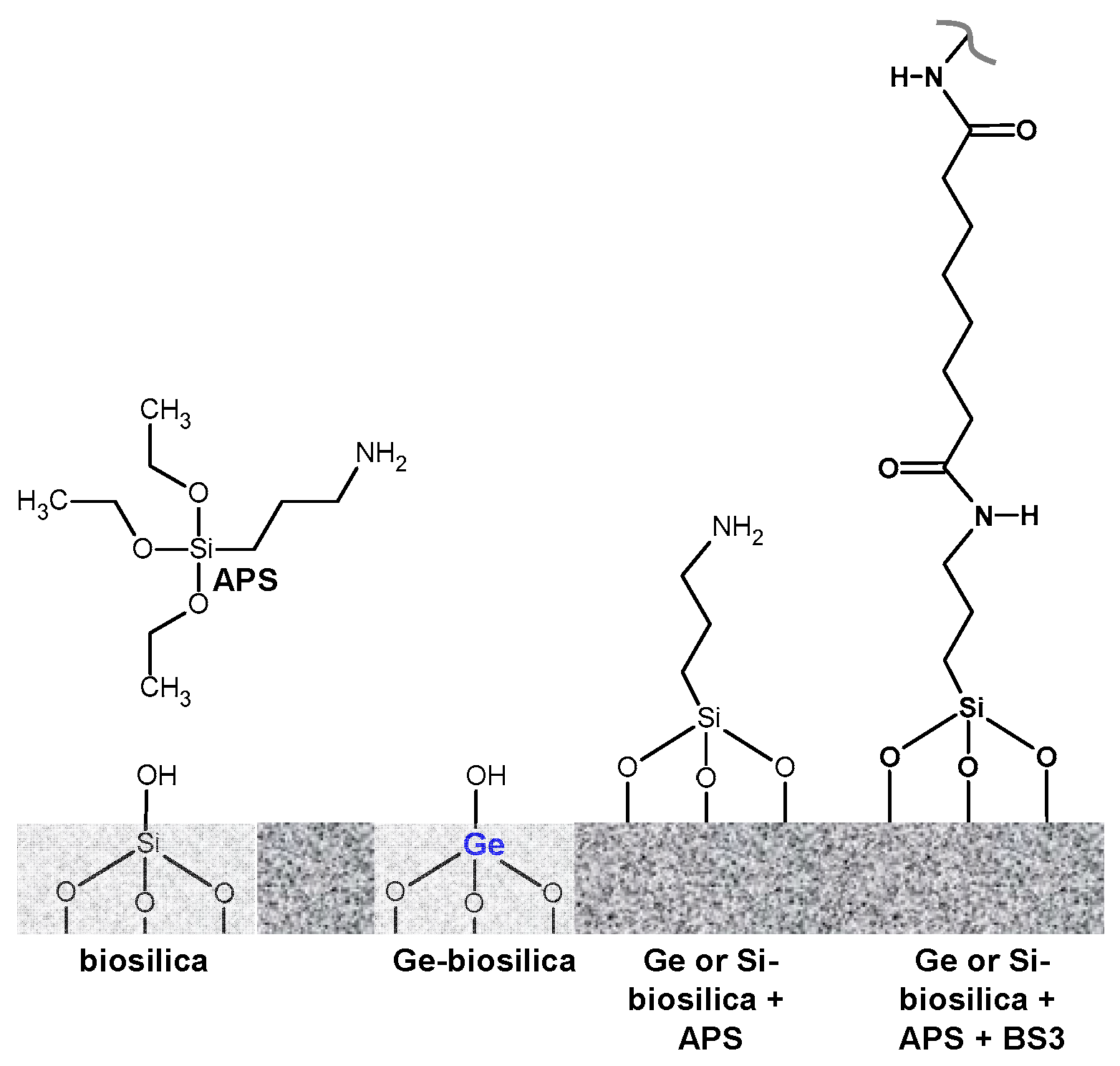
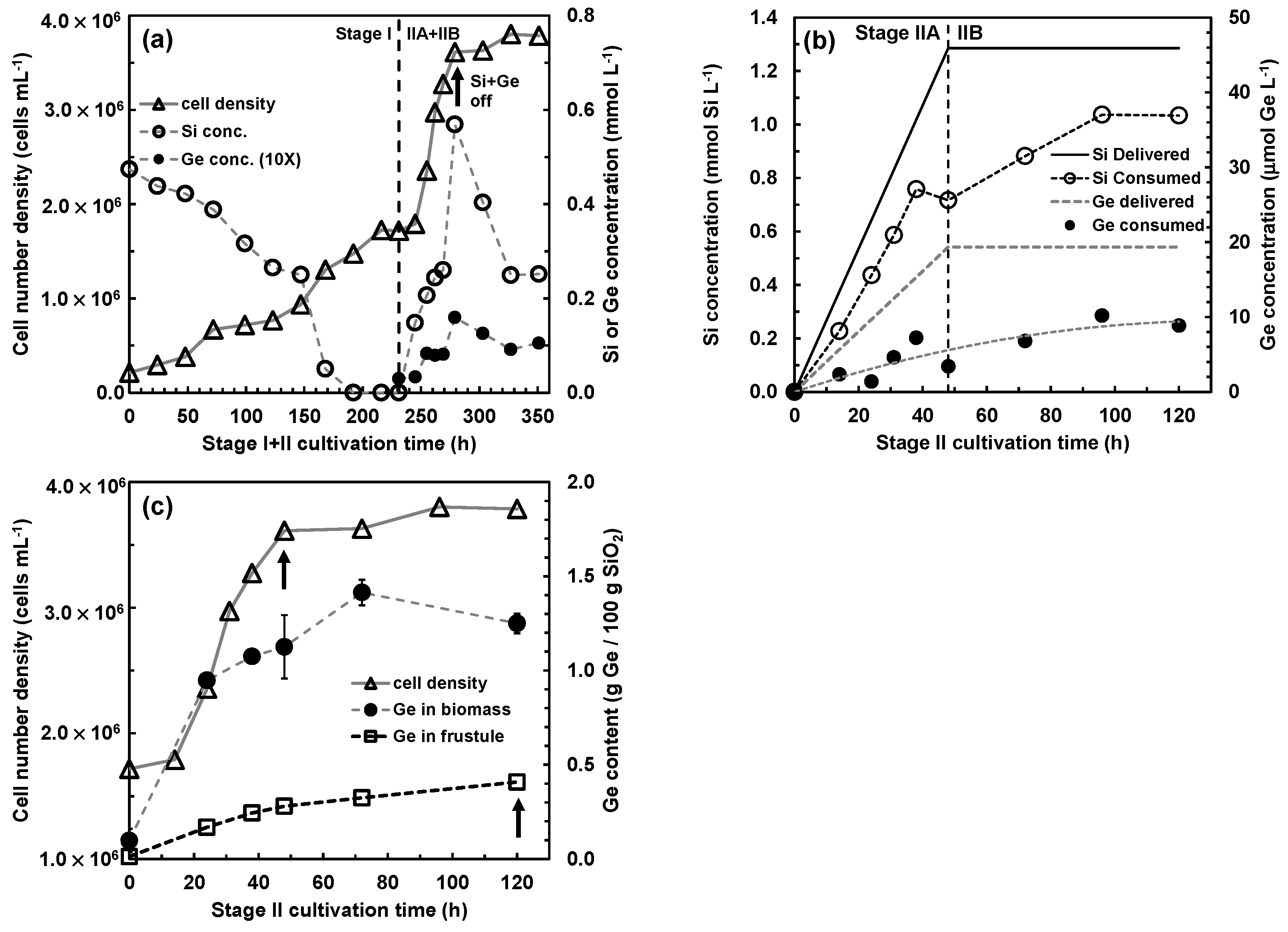
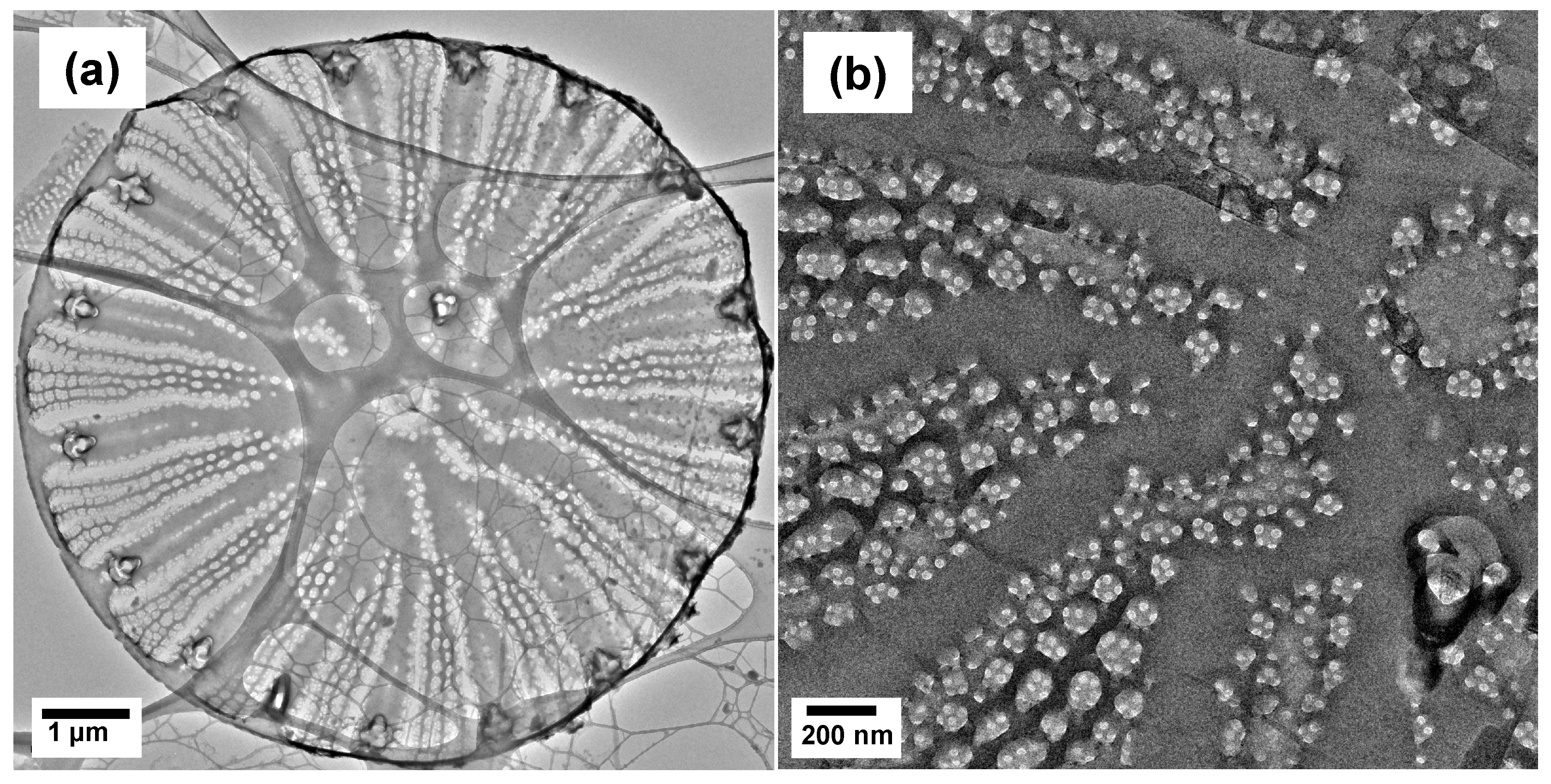
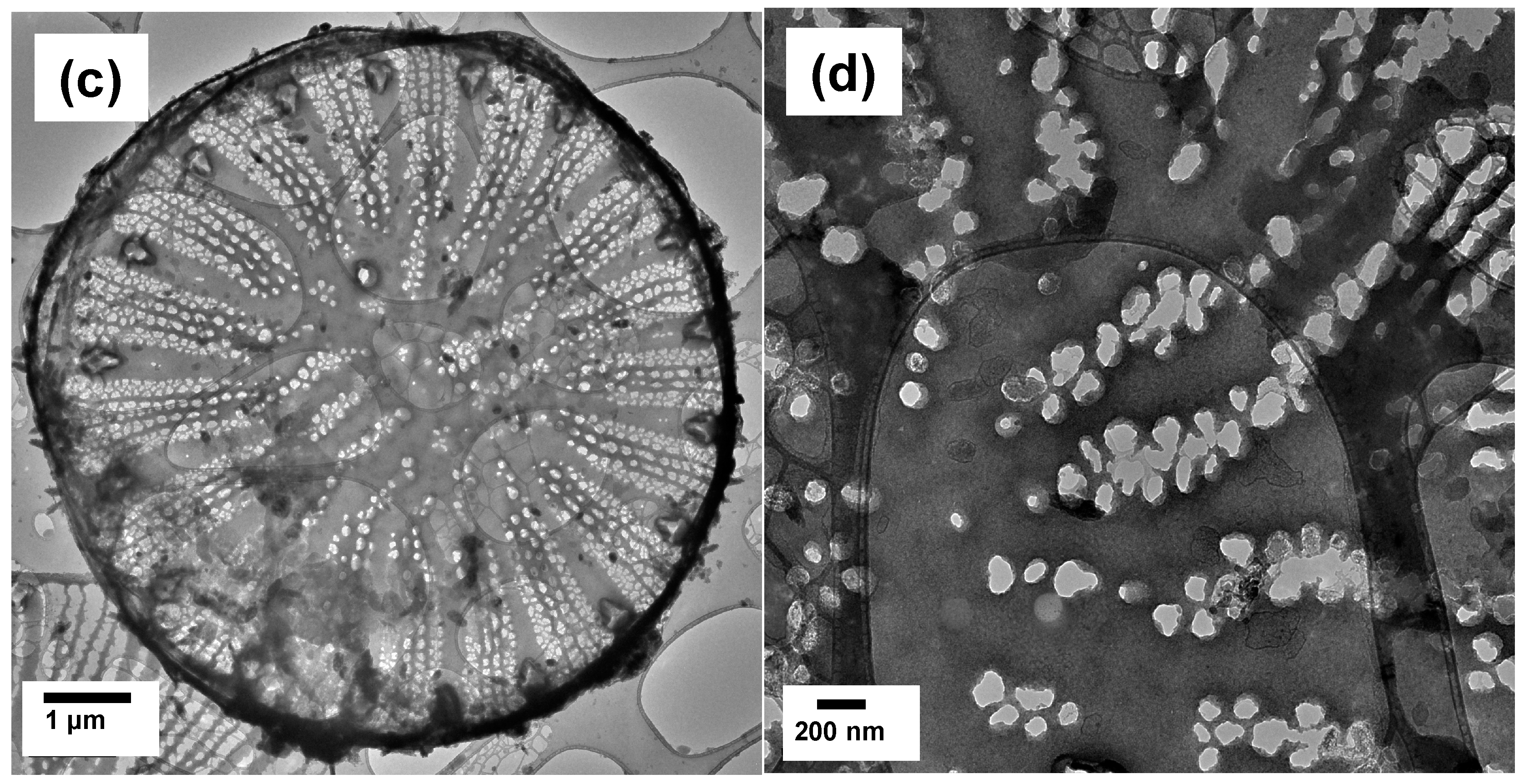
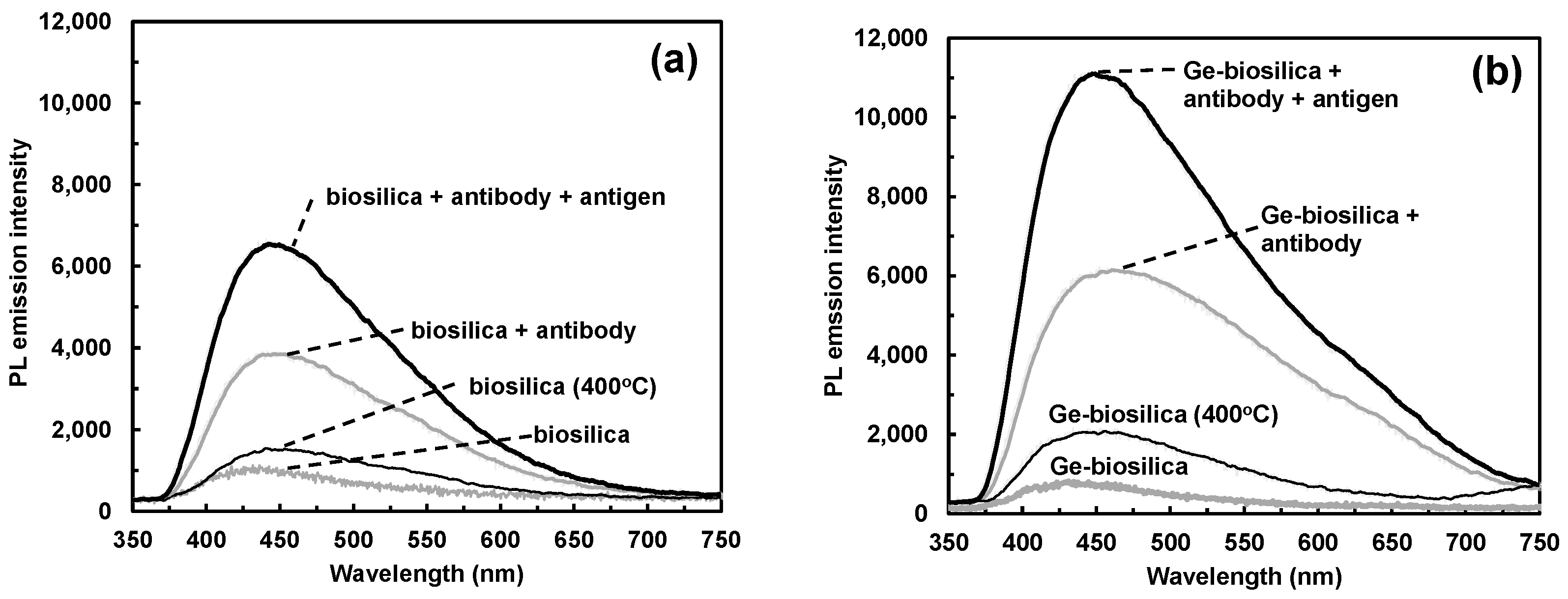
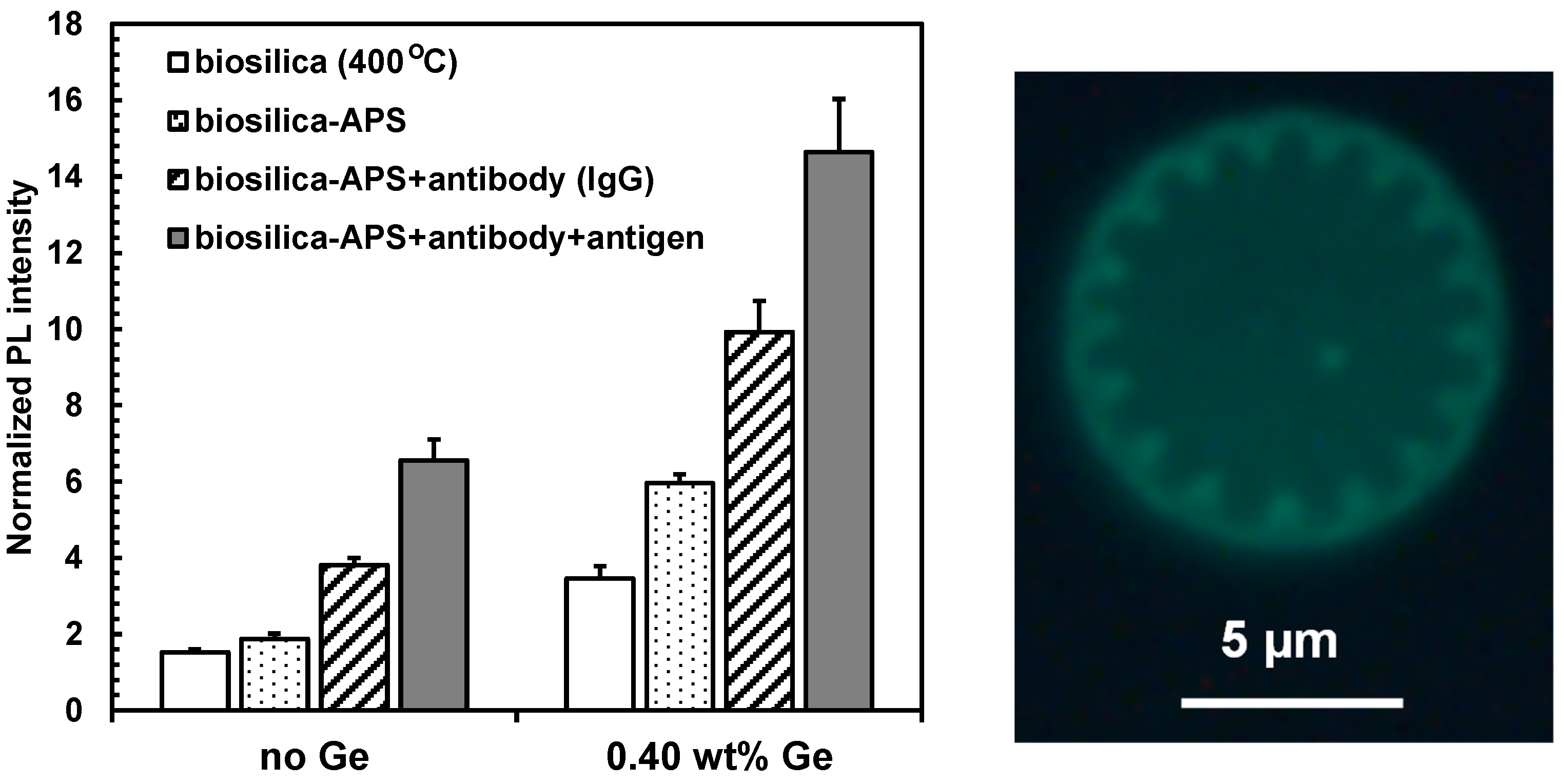
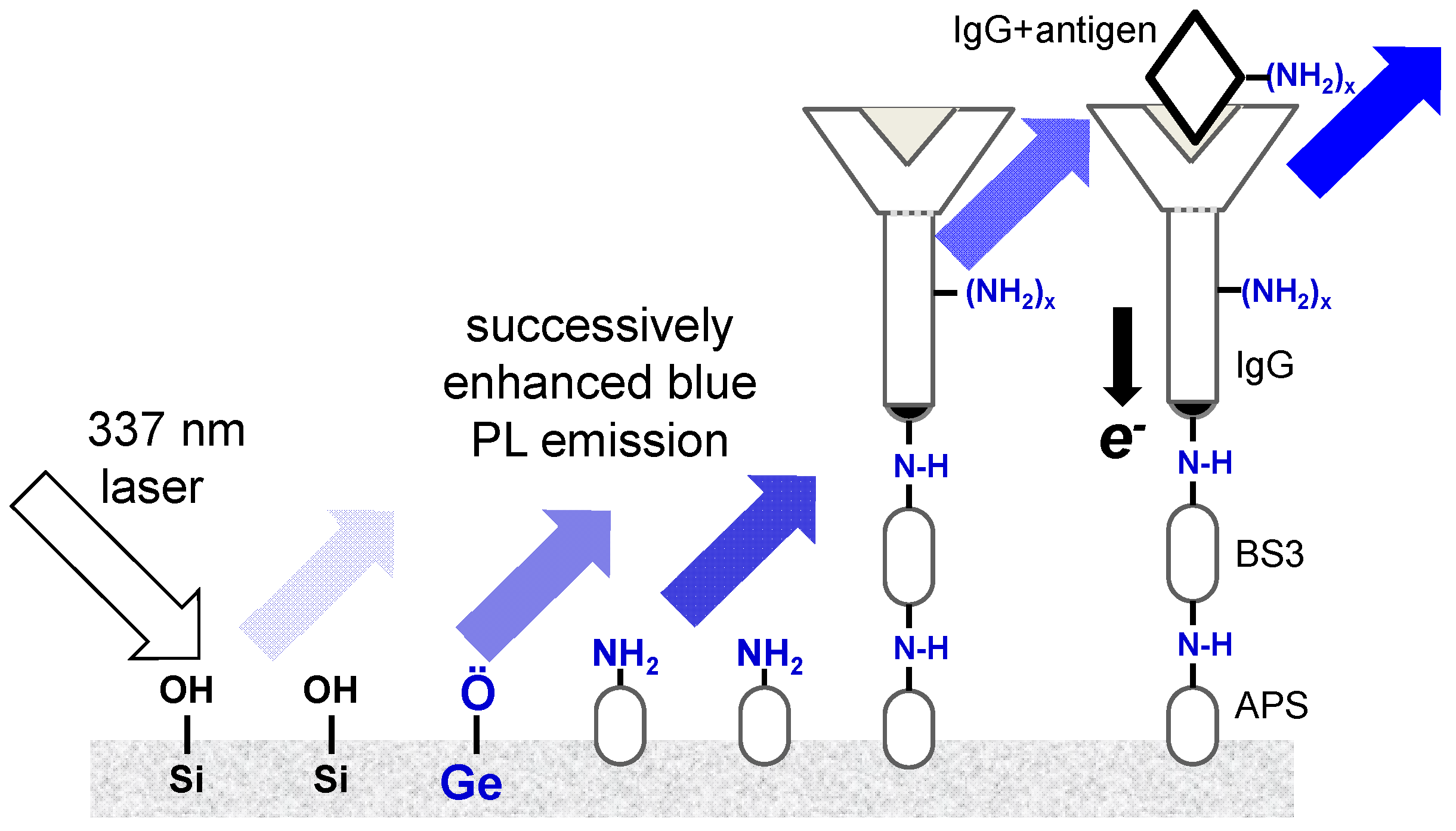
| Cultivation Parameter | Stage I | Stage IIA | Stage IIB | Final |
|---|---|---|---|---|
| Cultivation time (h) | 231 | 48 | 72 | 351 |
| Si conc. beginning of stage (mmol L−1) | 0.474 | 0.103 | 0.404 | |
| Si conc. end of stage (mmol L−1) | 0.103 | 0.404 | 0.252 | |
| Ge conc. beginning of stage (mmol L−1) | 0.0 | 3.0 | 16.0 | |
| Ge conc. end of stage (μmol L−1) | 0.0 | 16.0 | 10.5 | |
| Initial cell number density (cells mL−1) | 2.14 × 105 | 1.72 × 106 | 3.61 × 106 | |
| Final cell number density (cells mL−1) | 1.72 × 106 | 3.61 × 106 | 3.79 × 106 | 3.79 × 106 |
| Average pH | 8.6 | 9.3 | 8.8 | 8.6 |
| Si + Ge feed flowrate (mL feed L−1 h−1) | 0 | 0.86 | 0 | |
| Feed solution Si conc. (mM) | 0 | 31.3 | 0 | |
| Feed solution Ge conc. (mM) | 0 | 0.47 | 0 | |
| Si delivery rate (mmol Si L−1 h−1) | 0.027 | |||
| Ge delivery rate (μmol Ge L−1 h−1) | 0.40 | |||
| Total Si added (mmol Si L−1) | 0.474 | 1.29 | 0 | 1.76 |
| Total Ge added (μmol Ge L−1) | 0 | 19.3 | 19.3 |
| Substrate and Reactants | Value | Units |
|---|---|---|
| Biosilica frustule mass | 10.0 | mg |
| Frustule number | 1.8 × 108 | frustules/mg biosilica |
| Concentration APS | 2.80 | μM |
| Reaction volume | 2.0 | mL ethanol |
| Ratio APS/biosilica | 5.6 × 10−4 | μmol APS/mg biosilica |
| Molar ratio APS/SiO2 | 3.4 × 10−5 | mol APS/mol SiO2 |
| Avogadro’s Number | 6.02 × 1023 | molecules/mol |
| APS molecules per frustule | 1.87 × 106 | molecules APS/frustule |
| Surface density of IgG [10] | ~3000 | IgG sites/μm2 frustule surface |
| Frustule valve diameter | 8.0 | μm |
| IgG sites per frustule | 3.0 × 105 | IgG sites/frustule surface |
| APS molecules per IgG site | 6 | molecules APS/IgG site |
| Pairwise Comparison | p-Value | Pairwise Comparison | p-Value | ||
|---|---|---|---|---|---|
| BS vs. | Ge-BS | 4.4 × 10−3 | |||
| BS vs. | BS + AB | 4.1 × 10−5 | Ge-BS vs. | Ge-BS + AB | 2.2 × 10−4 |
| BS vs. | BS + AB + AG | 9.5 × 10−5 | Ge-BS vs. | Ge-BS + AB + AG | 1.7 × 10−4 |
| BS + AB vs. | BS + AB + AG | 1.2 × 10−3 | Ge-BS + AB vs. | Ge-BS + AB + AG | 7.2 × 10−3 |
| BS + AB vs. | Ge-BS + AB | 1.0 × 10−3 | Ge-BS + AB + AG vs. | BS + AB + AG | 6.2 × 10−3 |
Disclaimer/Publisher’s Note: The statements, opinions and data contained in all publications are solely those of the individual author(s) and contributor(s) and not of MDPI and/or the editor(s). MDPI and/or the editor(s) disclaim responsibility for any injury to people or property resulting from any ideas, methods, instructions or products referred to in the content. |
© 2023 by the authors. Licensee MDPI, Basel, Switzerland. This article is an open access article distributed under the terms and conditions of the Creative Commons Attribution (CC BY) license (https://creativecommons.org/licenses/by/4.0/).
Share and Cite
Gale, D.K.; Rorrer, G.L. Enhanced Photoluminescence Detection of Immunocomplex Formation by Antibody-Functionalized, Ge-Doped Biosilica from the Diatom Cyclotella sp. Nanomaterials 2023, 13, 1950. https://doi.org/10.3390/nano13131950
Gale DK, Rorrer GL. Enhanced Photoluminescence Detection of Immunocomplex Formation by Antibody-Functionalized, Ge-Doped Biosilica from the Diatom Cyclotella sp. Nanomaterials. 2023; 13(13):1950. https://doi.org/10.3390/nano13131950
Chicago/Turabian StyleGale, Debra K., and Gregory L. Rorrer. 2023. "Enhanced Photoluminescence Detection of Immunocomplex Formation by Antibody-Functionalized, Ge-Doped Biosilica from the Diatom Cyclotella sp." Nanomaterials 13, no. 13: 1950. https://doi.org/10.3390/nano13131950
APA StyleGale, D. K., & Rorrer, G. L. (2023). Enhanced Photoluminescence Detection of Immunocomplex Formation by Antibody-Functionalized, Ge-Doped Biosilica from the Diatom Cyclotella sp. Nanomaterials, 13(13), 1950. https://doi.org/10.3390/nano13131950





